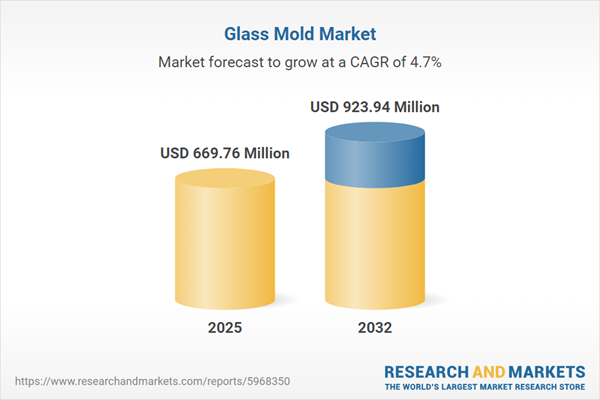Speak directly to the analyst to clarify any post sales queries you may have.
The Glass Mold Market is undergoing significant transformation as manufacturers adapt to evolving industry needs, sustainability imperatives, and technological advancements. This report is designed for senior decision-makers seeking actionable intelligence and strategic insights to support growth and operational excellence in glass mold manufacturing.
Market Snapshot – Glass Mold Market Growth and Outlook
The global glass mold market is expanding, with market size increasing from USD 639.91 million in 2024 to USD 669.76 million in 2025, and anticipated to reach USD 923.94 million by 2032. A compound annual growth rate (CAGR) of 4.69% underscores ongoing momentum, driven by robust demand in architectural, automotive, and consumer segments. Innovation in material science, process optimization, and digital technologies shapes the sector's competitive landscape.
Scope & Segmentation Analysis
This report provides comprehensive coverage of the glass mold market, detailing material compositions, applications, production technologies, and core end users. Regional insights span Americas, Europe, Middle East & Africa, and Asia-Pacific.
- Material Types: Ceramic (Alumina: Alpha Alumina, Epsilon Alumina; Zirconia: Magnesia Stabilized, Yttria Stabilized), Metal (Nickel: Monel, Pure Nickel; Steel: Carbon Steel, Stainless Steel), Silicon Carbide.
- Application Areas: Architectural Glass (Commercial, Residential), Automotive Glass (Rear Windows, Side Windows, Windshields), Decorative Glass (Panels, Tiles), Glassware (Bottles, Bowls, Drinkware), Optical Components (Lenses, Mirrors, Prisms).
- Production Technologies: Fusing (Chemical Fusing, Thermal Fusing), Press Molding (Multiple Station Press, Single Station Press), Slumping (Draping, Free Form Slumping).
- End Users: Automotive (Aftermarket, OEM), Construction (Commercial, Residential), Consumer Goods (Home Appliances, Tableware), Electronics (Display Panels, Fiber Optics), Medical (Lab Equipment, Surgical Instruments).
- Regional Coverage: North America (United States, Canada, Mexico), Latin America (Brazil, Argentina, Chile, Colombia, Peru), Europe (United Kingdom, Germany, France, Russia, Italy, Spain, Netherlands, Sweden, Poland, Switzerland), Middle East (UAE, Saudi Arabia, Qatar, Turkey, Israel), Africa (South Africa, Nigeria, Egypt, Kenya), Asia-Pacific (China, India, Japan, Australia, South Korea, Indonesia, Thailand, Malaysia, Singapore, Taiwan).
- Companies Profiled: Heye International GmbH, FIVES S.A., New Millennium Machinery, Inc., Tianjin Newint Group Co., Ltd., Zhangjiagang Sanxing Glass Machinery Manufacturing Co., Ltd.
Key Takeaways for Senior Decision-Makers
- Glass mold manufacturers are pivoting towards hybrid materials, such as ceramic composites and specialty metals, to unlock higher durability and precision for diverse end-use segments.
- Partnerships across the value chain—from raw material suppliers to OEMs—are accelerating R&D and the roll-out of digital solutions including real-time process monitoring and digital twins.
- Sustainable practices are taking precedence, with closed-loop recycling and resource-efficient processes adopted to align with global environmental standards and customer expectations.
- Service innovation, such as predictive maintenance contracts and custom prototyping, enables manufacturers to move beyond commodity mold sales and achieve longer-term client relationships.
- Region-specific growth strategies are emerging. The Americas benefit from supply chain infrastructure, while EMEA prioritizes green building partnerships and Asia-Pacific leads in scaling production and integrating Industry 4.0 technologies.
Tariff Impact and Strategic Industry Adjustments
The 2025 U.S. tariffs on imported raw materials have reshaped sourcing and production strategies in the glass mold market. Manufacturers are mitigating input cost pressures by increasing local procurement, investing in domestic material processing, and optimizing logistics networks. Some industry players are innovating with cost-effective material alternatives and pursuing greater upstream control to buffer future trade policy disruptions. The tariff environment acts as a catalyst for supply chain resilience and process innovation across the sector.
Methodology & Data Sources
This research adopts a rigorous, multi-tiered methodology, combining primary interviews with industry executives and engineers, and secondary research from technical literature, trade publications, and patent filings. Data triangulation ensures comprehensive validation and historical trend analysis informs both quantitative and qualitative scenario modeling.
Why This Report Matters
- Supports strategic decision-making by delivering granular data and actionable insights across regions and production technologies.
- Enables benchmarking of competitive positioning and identification of technology, partnership, and sustainability opportunities for growth.
- Prepares firms to navigate evolving regulatory environments and maintain resilience in global supply networks.
Conclusion
This authoritative market analysis equips leaders with the clarity, scope, and depth required for confident investment and strategic planning. The full report provides all necessary details to capitalize on current trends and forecast long-term industry shifts.
Additional Product Information:
- Purchase of this report includes 1 year online access with quarterly updates.
- This report can be updated on request. Please contact our Customer Experience team using the Ask a Question widget on our website.
Table of Contents
3. Executive Summary
4. Market Overview
7. Cumulative Impact of Artificial Intelligence 2025
Companies Mentioned
The companies profiled in this Glass Mold market report include:- Heye International GmbH
- FIVES S.A.
- New Millennium Machinery, Inc.
- Tianjin Newint Group Co., Ltd.
- Zhangjiagang Sanxing Glass Machinery Manufacturing Co., Ltd.
Table Information
| Report Attribute | Details |
|---|---|
| No. of Pages | 194 |
| Published | October 2025 |
| Forecast Period | 2025 - 2032 |
| Estimated Market Value ( USD | $ 669.76 Million |
| Forecasted Market Value ( USD | $ 923.94 Million |
| Compound Annual Growth Rate | 4.6% |
| Regions Covered | Global |
| No. of Companies Mentioned | 6 |









